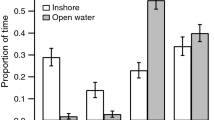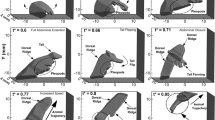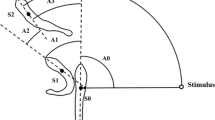Abstract
Escape maneuvers are essential to the survival and fitness of many animals. Escapes are frequently initiated when an animal is already in motion. This may introduce constraints that alter the escape performance. In fish, escape maneuvers and steady, body caudal fin (BCF) swimming are driven by distinct patterns of curvature of the body axis. Pre-existing muscle activity may therefore delay or diminish a response. To quantify the performance consequences of escaping in flow, escape behavior was examined in bluegill sunfish (Lepomis macrochirus) in both still-water and during steady swimming. Escapes executed during swimming were kinematically less variable than those made in still-water. Swimming escapes also had increased response latencies and lower peak velocities and accelerations than those made in still-water. Performance was also lower for escapes made up rather than down-stream, and a preference for down-stream escapes may be associated with maximizing performance. The constraints imposed by pre-existing motion and flow, therefore, have the potential to shape predator–prey interactions under field conditions by shifting the optimal strategies for both predators and prey.





Similar content being viewed by others
References
Altringham JD, Ellerby DJ (1999) Fish swimming: patterns in muscle function. J Exp Biol 202:3397–3403
Arnott SA, Neil DM, Ansell AD (1999) Escape trajectories of the brown shrimp Crangon crangon, and a theoretical consideration of initial escape angles from predators. J Exp Biol 202:193–209
Card GM (2012) Escape behaviors in insects. Curr Opin Neurobiol 22:180–186
Carroll AM, Ambrose AM, Anderson TA, Coughlin DJ (2009) Feeding muscles scale differently from swimming muscles in sunfish (Centrarchidae). Biol Lett 5:274–277
Catania KC (2009) Tentacled snakes turn C-starts to their advantage and predict future prey behaviour. Proc Natl Acad Sci USA 107:11183–11187
Daniel TL (1984) Unsteady aspects of aquatic locomotion. Am Zool 24:121–134
Diamond KM, Schoenfuss HL, Walker JA, Blob RW (2016) Is fish escape performance influenced by flow? Tests in the Hawaiian stream goby Sicyopterus simpsoni. Integr Comp Biol 56(suppl 1):e53
Domenici P (2010) Context-dependent variability in the components of fish escape response: integrating locomotor performance and behaviour. J Exp Zool Part A 313:59–79
Domenici P, Blake RW (1997) The kinematics and performance of fish fast-start swimming. J Exp Biol 200:1165–1178
Domenici P, Blagburn JM, Bacon JP (2011a) Animal escapology I: theoretical issues and emerging trends in escape trajectories. J Exp Biol 214:2463–2473
Domenici P, Blagburn JM, Bacon JP (2011b) Animal escapology II: escape trajectory case studies. J Exp Biol 214:2474–2494
Domenici P, Wilson ADM, Kurvers RHJM, Marras S, Herbert-Read JE, Steffensen JF, Krause S, Viblanc PE, Couillaud P, Krause J (2014) How sailfish use their bills to capture schooling prey. Proc R Soc B 281:20140444. doi:10.1098/rspb.2014.0444
Eaton RC, Emberley DS (1991) How stimulus direction determines the trajectory of the mauthner-initiated escape response in a teleost fish. J Exp Biol 161:469–487
Eaton RC, Lavender WA, Wieland CM (1981) Identification of Mauthner-initiated response patterns in goldish: evidence from simultaneous cinematography and electrophysiology. J Comp Physiol 144:521–531
Ellerby DJ, Altringham JD, Williams T, Block BA (2000) Slow muscle function of Pacific bonito (Sarda chiliensis) during steady swimming. J Exp Biol 203:2001–2013
Gerry SP, Robbins A, Ellerby D (2012) Variation in fast-start performance within a polyphenic population of bluegill sunfish (Lepomis macrochirus). Physiol Biochem Zool 85:694–703
Ghalambor CK, Reznick DN, Walker JA (2004) Constraints on adaptive evolution: the functional trade-off between reproduction and fast-start swimming performance in the Trinidadian guppy (Poecilia reticulata). Am Nat 164:38–50
Goldbogen JA, Shadwick RE, Fudge DS, Gosline JM (2005) Fast-start muscle dynamics in the rainbow trout Oncorhynchus mykiss: phase relationship of white muscle shortening and midline curvature. J Exp Biol 208:929–938
Hale ME (2002) S- and C-start escape responses of the muskellunge (Esox masquinongy) require alternative neuromotor mechanisms. J Exp Biol 205:2005–2016
Harper DG, Blake RW (1991) Prey capture and the fast-start performance of Northern Pike Esox lucius. J Exp Biol 155:175–192
Hedenström A, Rosén M (2001) Predator versus prey: on aerial hunting and escape strategies in birds. Behav Ecol 12:150–156
Hitchcock AC, Chen T, Connolly E, Darakananda K, Jeong J, Quist A, Robbins A, Ellerby DJ (2015) Trade-offs between performance and variability in the escape responses of bluegill sunfish (Lepomis macrochirus). Biol Open. doi:10.1242/bio.201511577
Hoogland R, Morris D, Tinbergen N (1956) The spines of sticklebacks (Gasterosteus and Pygosteus) as means of defence against predators (Perca and Esox). Behaviour 10:205–236
Howland HC (1974) Optimal strategies for predator avoidance: the relative importance of speed and manoeuverability. J Theor Biol 47:333–350
Humphries DA, Driver PM (1970) Protean defence by prey animals. Oecologia 5:285–302
Husak JF (2006) Does survival depend on how fast you can run or how fast you do run? Funct Ecol 20:1080–1086
Jablonski PG, Strausfeld NJ (2001) Exploitation of an ancient escape circuit by an avian predator: relationships between taxon-specific prey escape circuits and the sensitivity to visual cues by a predator. Brain Behav Evol 58:218–240
Jayne BC, Lauder GV (1993) Red and white muscle activity and kinematics of the escape response of the bluegill sunfish during swimming. J Comp Physiol A 173:495–508
Katzir G, Camhi JM (1993) Escape response of black mollies (Poecilia sphenops) to predatory dives of a pied kingfisher (Ceryle rudis). Copeia 1993:549–553
Katzir G, Intrator N (1987) Striking of underwater prey by reef herons, Egretta gularis schistaeea. J Comp Physiol A 60:517–523
Katzir G, Tamir S, Schechtman E, Hareli S, Arad Z (1999) Cattle egrets are less able to cope with light refraction than are other herons. Anim Behav 57:687–694
Kullberg C, Jakobsson S, Fransson T (1998) Predator induced take-off strategy in great tits (Parus major). Proc R Soc Lond B 265:1659–1664
Lotem A, Schechtman E, Katir G (1991) Capture of submerged prey by little egrets, Egretta garzetta garzetta: strike depth, strike angle and the problem of light refraction. Anim Behav 42:341–346
Marczak W (1997) Water as a standard in the measurements of speed of sound in liquids. J Acoust Soc Am 102:2776–2779
Mardia KV (1972) A multi-sample uniform scores test on a circle and its parametric competitor. J R Stat Soc Ser B 34:102–111
Marras S, Killen SS, Claireaux G, Domenici P, Domenici P, McKenzie DJ (2011) Behavioural and kinematic components of the fast-start escape response in fish: individual variation and temporal repeatability. J Exp Biol 214:3102–3110
Miles DB (2004) The race goes to the swift: fitness consequences of variation in sprint performance in juvenile lizards. Evol Ecol Res 6:63–75
Nauen JC, Shadwick RE (2001) The dynamics and scaling of force production during the tail-flip escape response of the California spiny lobster Panulirus interruptus. J Exp Biol 204:1817–1830
Rubin AM, Diamond KM, Schoenfuss HL, Blob RW (2016) Field observation of intraspecific and predatory attack behaviors of the Hawaiian sleeper fish, Eleotris sandwicensis. Integr Comp Biol 56(suppl 1):e53
Shadwick RE, Gemballa S (2006) Structure, kinematics, and muscle dynamics in undulatory swimming. In: Shadwick RE, Lauder GV (eds) Fish Biomechanics. Fish Physiology vol 23. Academic Press, San Diego, pp 241–280
Soto A, Stewart WJ, McHenry MJ (2015) When optimal strategy matters to prey fish. Int Comp Biol 55:110–120
Spierts IL, van Leeuwen JL (1999) Kinematics and muscle dynamics of C- and S-starts of carp (Cyprinus carpio L.). J Exp Biol 202:393–406
Svoboda KR, Fetcho JR (1996) Interactions between the neural networks for escape and swimming in goldfish. J Neurosci 16:843–852
Tytell ED, Lauder GV (2008) Hydrodynamics of the escape response in bluegill sunfish, Lepomis macrochirus. J Exp Biol 211:3359–3369
Wakeling JM (2006) Fast-start mechanics. In: Shadwick RE, Lauder GV (eds) Fish biomechanics, fish physiology, vol 23. Academic Press, San Diego, pp 333–368
Walker JA (1998) Estimating velocities and accelerations of animal locomotion: a simulation experiment comparing numerical differentiation algorithms. J Exp Biol 201:981–995
Walker JA, Ghalambor CK, Griset OL, McKenney D, Reznick DN (2005) Do faster starts increase the probability of evading predators? Funct Ecol 19:808–815
Watkins TB (1996) Predator-mediated selection on burst swimming performance in tadpoles of the Pacific tree frog, Pseudacris regilla. Physiol Zool 69:154–167
Webb PW (1976) The effect of size on the fast-start performance of rainbow trout Salmo gairdneri, and a consideration of piscivorous predator-prey interactions. J Exp Biol 65:157–177
Webb PW (1978) Fast-start performance and body form in seven species of teleost fish. J Exp Biol 74:211–226
Weihs D (1973) The mechanism of rapid starting in slender fish. Biorheology 10:343–350
Wöhl S, Schuster S (2007) The predictive start of hunting archer fish: a flexible and precise motor pattern performed with the kinematics of an escape C-start. J Exp Biol 210:311–324
Acknowledgments
The work was supported by the Department of Biological Sciences at Wellesley College, a Wellesley College Faculty Research Grant, and National Science Foundation grant 1354274 to DE. All procedures were approved by the Institutional Animal Care and Use Committee at Wellesley College.
Author information
Authors and Affiliations
Corresponding author
Rights and permissions
About this article
Cite this article
Anwar, S.B., Cathcart, K., Darakananda, K. et al. The effects of steady swimming on fish escape performance. J Comp Physiol A 202, 425–433 (2016). https://doi.org/10.1007/s00359-016-1090-3
Received:
Revised:
Accepted:
Published:
Issue Date:
DOI: https://doi.org/10.1007/s00359-016-1090-3




